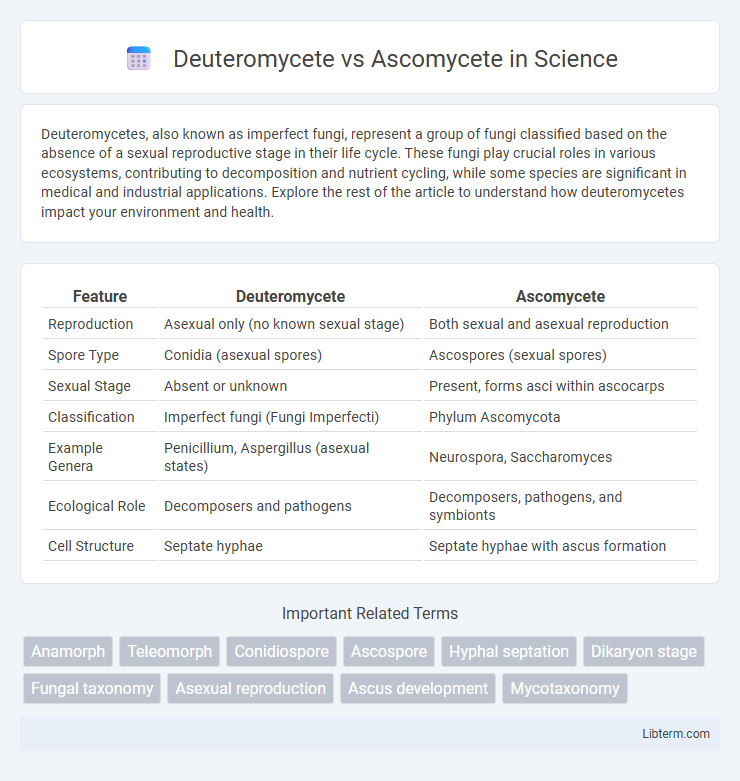Deuteromycetes, also known as imperfect fungi, represent a group of fungi classified based on the absence of a sexual reproductive stage in their life cycle. These fungi play crucial roles in various ecosystems, contributing to decomposition and nutrient cycling, while some species are significant in medical and industrial applications. Explore the rest of the article to understand how deuteromycetes impact your environment and health.
Table of Comparison
| Feature | Deuteromycete | Ascomycete |
|---|---|---|
| Reproduction | Asexual only (no known sexual stage) | Both sexual and asexual reproduction |
| Spore Type | Conidia (asexual spores) | Ascospores (sexual spores) |
| Sexual Stage | Absent or unknown | Present, forms asci within ascocarps |
| Classification | Imperfect fungi (Fungi Imperfecti) | Phylum Ascomycota |
| Example Genera | Penicillium, Aspergillus (asexual states) | Neurospora, Saccharomyces |
| Ecological Role | Decomposers and pathogens | Decomposers, pathogens, and symbionts |
| Cell Structure | Septate hyphae | Septate hyphae with ascus formation |
Introduction to Deuteromycetes and Ascomycetes
Deuteromycetes, often called imperfect fungi, lack a known sexual reproductive stage, distinguishing them from Ascomycetes, which reproduce sexually through the formation of asci containing ascospores. Ascomycetes are a diverse phylum with significant ecological roles, including decomposition and symbiosis, and they are characterized by septate hyphae and the production of asci within fruiting bodies. Deuteromycetes were historically classified based on asexual reproduction structures but many have been reclassified into Ascomycetes and Basidiomycetes following molecular analysis.
Taxonomic Classification Differences
Deuteromycetes, also known as Fungi Imperfecti, are classified based on the absence of a known sexual reproductive stage, whereas Ascomycetes are defined by the presence of asci, specialized sac-like structures producing sexual spores called ascospores. Taxonomically, Deuteromycetes are regarded as a form group rather than a phylogenetic clade, often reclassified into Ascomycetes upon discovery of their sexual cycle. The presence or absence of sexual reproduction is the primary taxonomic criterion distinguishing Deuteromycetes from Ascomycetes within fungal classification systems.
Morphological Characteristics Comparison
Deuteromycetes, also known as Fungi Imperfecti, lack a known sexual reproductive stage and primarily reproduce asexually through conidia formed on conidiophores, whereas Ascomycetes produce sexual spores called ascospores contained within specialized sac-like structures called asci. Morphologically, Deuteromycetes exhibit diverse conidial forms and arrangements without the presence of asci, while Ascomycetes often have complex fruiting bodies such as ascocarps where asci are embedded. The presence of septate hyphae is common in both groups, but Ascomycetes display characteristic ascus development that is absent in Deuteromycetes, reflecting their different reproductive morphologies.
Reproductive Strategies: Sexual vs. Asexual
Deuteromycetes primarily reproduce asexually through conidia formation, lacking a known sexual reproductive stage, which distinguishes them from Ascomycetes that exhibit both sexual and asexual reproduction phases. Ascomycetes produce sexual spores called ascospores within sac-like structures called asci, facilitating genetic recombination and adaptability. The presence of a well-defined sexual cycle in Ascomycetes contributes to their evolutionary diversity, while Deuteromycetes rely on rapid asexual propagation for survival and colonization.
Life Cycle Distinctions
Deuteromycetes, often referred to as "imperfect fungi," primarily reproduce asexually through conidia due to the absence of a known sexual stage in their life cycle. Ascomycetes exhibit a well-defined sexual reproduction cycle involving the formation of asci, where meiotic spores called ascospores are produced. The life cycle of Ascomycetes features both sexual and asexual phases, enabling genetic recombination, whereas Deuteromycetes rely predominantly on asexual propagation methods.
Ecological Roles and Habitat Preference
Deuteromycetes primarily act as decomposers and pathogens, thriving in soil, decaying organic matter, and plant hosts, impacting nutrient cycling and plant health. Ascomycetes exhibit diverse ecological roles, including saprobes, pathogens, and symbionts, frequently inhabiting terrestrial and freshwater ecosystems such as leaf litter, bark, and lichens. Both groups contribute significantly to ecosystem functioning, with Ascomycetes generally showing broader habitat versatility and complex symbiotic relationships.
Economic and Medical Importance
Deuteromycetes, or imperfect fungi, play a crucial role in biotechnology and industry by producing antibiotics like penicillin and enzymes used in food processing. Ascomycetes, known as sac fungi, contribute significantly to pharmaceuticals, yielding important drugs such as cyclosporine and statins, while also impacting agriculture through plant pathogenic species. Both groups influence economic sectors by providing essential bioactive compounds, but Ascomycetes have a broader range of applications in medical mycology and industrial fermentation.
Genetic and Molecular Insights
Deuteromycetes, also known as Fungi Imperfecti, lack a known sexual reproductive stage, limiting insights into their complete genetic cycles compared to Ascomycetes, which possess well-defined sexual and asexual phases encoded by distinct gene clusters such as MAT loci. Molecular studies reveal that Ascomycetes have highly conserved genes regulating meiosis and spore formation, facilitating advanced genetic manipulation and evolutionary analysis, whereas Deuteromycetes often show genetic divergence and incomplete genomic data due to their cryptic sexual stages. Comparative genomics highlights significant differences in secondary metabolite gene clusters and regulatory pathways, underscoring the evolutionary complexity between these fungal groups based on their reproductive genetic frameworks.
Key Examples and Representative Species
Deuteromycetes, commonly known as imperfect fungi, include key examples like *Fusarium* and *Penicillium*, which lack a known sexual reproductive stage. Ascomycetes, or sac fungi, encompass well-known species such as *Saccharomyces cerevisiae* and *Aspergillus*, characterized by their production of ascospores within asci. These groups differ significantly in life cycle complexity and ecological roles, with Ascomycetes typically exhibiting both sexual and asexual reproduction.
Summary: Major Differences and Similarities
Deuteromycetes, known as fungi imperfecti, lack a known sexual reproductive stage, while Ascomycetes reproduce sexually through the formation of asci containing ascospores. Both groups are filamentous fungi with septate hyphae and play critical roles in decomposition and symbiotic relationships. Despite their reproductive differences, both contribute significantly to ecological nutrient cycling and have importance in biotechnology and medicine.
Deuteromycete Infographic

 libterm.com
libterm.com